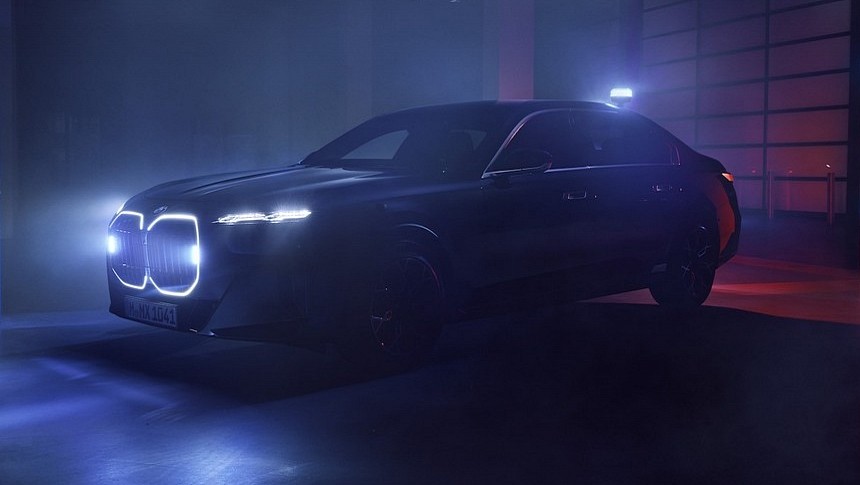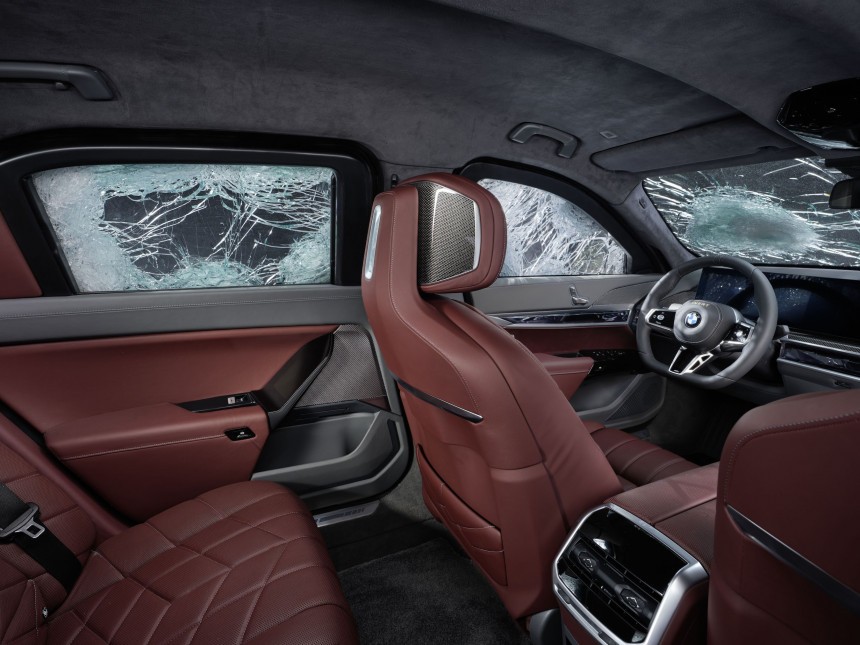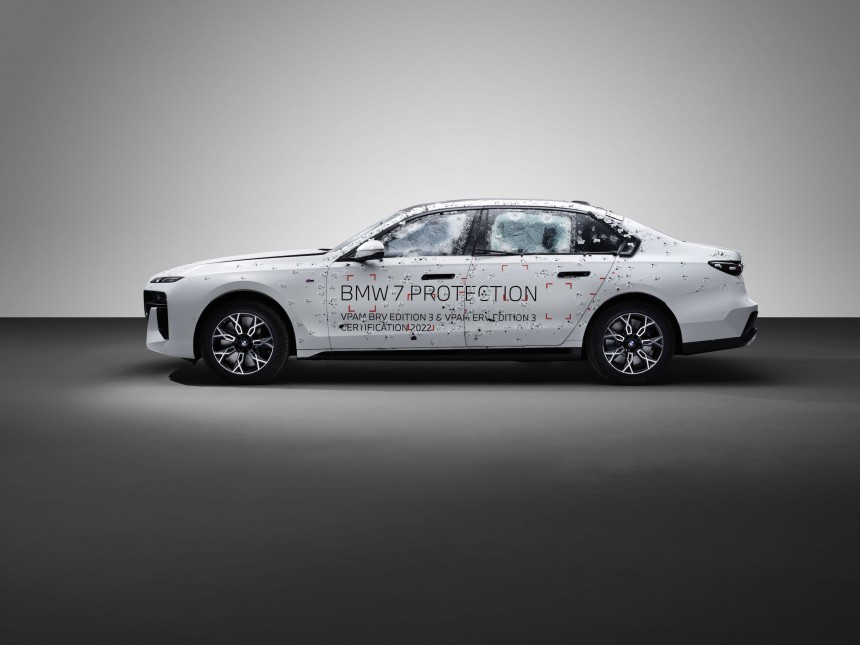On May 19, I published an article about companies that armor Tesla vehicles. Clearly, being bullet-proof was not all these battery electric vehicles (BEVs) needed to offer. The added weight significantly reduced their ranges, which is also a safety factor. Performance must also have been affected, but there was no data to confirm that. BMW just provided more evidence through the i7 Protection that BEVs and armored vehicles do not go well together.
Being the first factory-armored BEV was not very good for the electric sedan. The German carmaker cleverly avoided touching sensitive topics such as range and mass gain, but there are some elements that show the impact of the armor materials.
The i7 xDrive60 goes from 0 to 100 kph (62 mph) in 4.7 seconds and has a top speed that is electronically limited to 240 kph (149.1 mph). The i7 Protection takes 9 seconds to reach the same speed from a standstill, and BMW limited its top speed to 160 kph (99.4 mph). In both vehicles, the maximum speed is restricted to preserve the range, which the German automaker only discloses for the i7 xDrive60: from 591 kilometers (367.2 miles) to 625 km (388.4 mi) under the WLTP cycle.
Weirdly, these numbers do not match the energy consumption BMW discloses for its luxury BEV: 18.4 kWh/100 km in the best-case scenario and 19.6 kWh/100 km in the worst. The battery pack has a total capacity of 107.8 kWh, but the usable capacity is 101.7 kWh. Do the calculations with the latter, and the range will go from 518.9 km (322.4 mi) to 552.7 km (343.4 mi). If the total capacity is used, the numbers range from 550 km (341.8 mi) to 585.9 km (364 mi). The battery pack would have to deliver 115 kWh for the numbers to match.
The only information related to the range that BMW publicly disclosed is that the i7 Protection needs 30 kWh/100 km. That's 53% more than the worse energy consumption and 63% more than the best figure from the i7 xDrive60. The range for a 101.7-kWh battery pack would be 338 km (210 mi), a massive drop compared to the numbers presented by the electric sedan without armor: 42.8% (591 km) or 45.9% (625 km). If we use the hypothetical 115-kWh battery pack in the calculations, the i7 Protection range grows to 383.3 km (238.2 mi). Despite the improvement, the armor still makes the range nosedive: 35.1% (591 km) or 38.7% (625 km).
I asked BMW about the range and the masses of its armored vehicles. The provisional range of the i7 Protection is 380 km (236.1 mi), which almost matches the calculation I made with a 115-kWh battery pack that does not exist. The electric sedan has a curb weight of 4,450 kilograms (9,810.6 pounds). The i7 xDrive60 tips the scale at 2,715 kg (5,985.6 lb). That's 63.9% more than the regular electric sedan. The 7 Series Protection weighs 3,965 kg (8,741.3 lb), while the 760i xDrive – which uses the same 4.4-liter V8 – presents a mass of 2,345 kg (5,169.8 lb), a 69.1% difference. Although the internal combustion version has a higher weight penalty, it suffers less from it.
The 7 Series Protection has a fuel consumption of 15.6 liters/100 km. The gasoline tank that holds 74 liters means it has a range of 474.4 km (294.8 mi). The 760i xDrive needs 11.2 l/100 km, which raises the range to 660.7 km (410.5 mi). The difference is 28.2%. That's part of what allows the 7 Series Protection to offer an optional VPAM 10 protection level – the i7 Protection cannot have it. The ICE armored car still has at least three crucial advantages compared to its BEV sibling: the higher range, better performance numbers, and the "charging speed."
Just think about it: armored cars are made to resist an attack long enough to allow the attacked person to escape. Both the i7 Protection and the 7 Series Protection come with VPAM 9 protection levels and VPAM 10 windows. The VPAM 9 protection level can resist three shots of 7.62×51 mm P80 armor-piercing bullets (used by M14 rifles or M60 machine guns), spaced 120 mm (4.7 inches) apart, from a distance of around 10 meters. The VPAM 10 windows can hold 7.62x54 mm R ammunition used by SV-98 sniper rifles under the same conditions. The mere description of what these vehicles have to handle shows how urgent it is to escape as soon as possible and avoid multiple shots in the same area.
The faster the armored vehicles can run, the higher the possibility they can get somewhere safe or reach help. The 7 Series Protection goes from 0 to 100 kph in 6.6 seconds and has a top speed of 210 kph (130.5 mph). Several vehicles can run at 160 kph, which is the i7 Protection's limit. If you fear having your car shot, these numbers make the V8 the obvious choice. Why would you choose a heavier and slower vehicle to protect your life? To avoid carbon emissions? In an emergency, would you prefer to spend at least 30 minutes waiting for a vehicle to recover part of its range or 5 minutes to fill up the tank and keep going? Remember: the point of armored cars is to protect their passengers from armed assaults. Doing so without carbon emissions would be nice, but only if it does not affect the main purpose of armored vehicles.
For BMW, the good news is that it offers a suitable alternative. Something it can also celebrate is that it will only sell these cars in Europe due to homologation matters. That is a continent in which this level of protection is probably even unnecessary – unless we are talking about Ukraine. If BMW were to sell these cars in Mexico, Brazil, or any of the biggest armored car markets, the i7 Protection would not stand a chance even against the friendly fire coming from the 7 Series Protection. BEVs are definitely not meant to get armor, at least not in their current configuration.
The i7 xDrive60 goes from 0 to 100 kph (62 mph) in 4.7 seconds and has a top speed that is electronically limited to 240 kph (149.1 mph). The i7 Protection takes 9 seconds to reach the same speed from a standstill, and BMW limited its top speed to 160 kph (99.4 mph). In both vehicles, the maximum speed is restricted to preserve the range, which the German automaker only discloses for the i7 xDrive60: from 591 kilometers (367.2 miles) to 625 km (388.4 mi) under the WLTP cycle.
Weirdly, these numbers do not match the energy consumption BMW discloses for its luxury BEV: 18.4 kWh/100 km in the best-case scenario and 19.6 kWh/100 km in the worst. The battery pack has a total capacity of 107.8 kWh, but the usable capacity is 101.7 kWh. Do the calculations with the latter, and the range will go from 518.9 km (322.4 mi) to 552.7 km (343.4 mi). If the total capacity is used, the numbers range from 550 km (341.8 mi) to 585.9 km (364 mi). The battery pack would have to deliver 115 kWh for the numbers to match.
I asked BMW about the range and the masses of its armored vehicles. The provisional range of the i7 Protection is 380 km (236.1 mi), which almost matches the calculation I made with a 115-kWh battery pack that does not exist. The electric sedan has a curb weight of 4,450 kilograms (9,810.6 pounds). The i7 xDrive60 tips the scale at 2,715 kg (5,985.6 lb). That's 63.9% more than the regular electric sedan. The 7 Series Protection weighs 3,965 kg (8,741.3 lb), while the 760i xDrive – which uses the same 4.4-liter V8 – presents a mass of 2,345 kg (5,169.8 lb), a 69.1% difference. Although the internal combustion version has a higher weight penalty, it suffers less from it.
The 7 Series Protection has a fuel consumption of 15.6 liters/100 km. The gasoline tank that holds 74 liters means it has a range of 474.4 km (294.8 mi). The 760i xDrive needs 11.2 l/100 km, which raises the range to 660.7 km (410.5 mi). The difference is 28.2%. That's part of what allows the 7 Series Protection to offer an optional VPAM 10 protection level – the i7 Protection cannot have it. The ICE armored car still has at least three crucial advantages compared to its BEV sibling: the higher range, better performance numbers, and the "charging speed."
The faster the armored vehicles can run, the higher the possibility they can get somewhere safe or reach help. The 7 Series Protection goes from 0 to 100 kph in 6.6 seconds and has a top speed of 210 kph (130.5 mph). Several vehicles can run at 160 kph, which is the i7 Protection's limit. If you fear having your car shot, these numbers make the V8 the obvious choice. Why would you choose a heavier and slower vehicle to protect your life? To avoid carbon emissions? In an emergency, would you prefer to spend at least 30 minutes waiting for a vehicle to recover part of its range or 5 minutes to fill up the tank and keep going? Remember: the point of armored cars is to protect their passengers from armed assaults. Doing so without carbon emissions would be nice, but only if it does not affect the main purpose of armored vehicles.
For BMW, the good news is that it offers a suitable alternative. Something it can also celebrate is that it will only sell these cars in Europe due to homologation matters. That is a continent in which this level of protection is probably even unnecessary – unless we are talking about Ukraine. If BMW were to sell these cars in Mexico, Brazil, or any of the biggest armored car markets, the i7 Protection would not stand a chance even against the friendly fire coming from the 7 Series Protection. BEVs are definitely not meant to get armor, at least not in their current configuration.




















